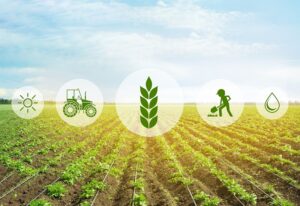Data is the Key to Achieving Future Sustainability Goals
In the regenerative agriculture movement, supply chain players that take a new approach to data reap the biggest benefits from the latest farming revolution.
By Karli Petrovic
Sustainability may be the agriculture industry’s biggest buzzword, but there’s merit to the hype. Everyone along the supply chain is motivated to meet their customers’ demands for safer food, products, and practices.

From the farmers who adopt variable-rate application methodologies to the retailers supplying the biorational products, sustainability tends to take the form of yield output through hardware, chemical usage, and growing practices. The data that generates better yields and more sustainable growing practices will play a broader role in in monitoring progress and proving the validity of future solutions.
“Sustainability of the future is not going to happen with one farmer and one set of data,” says Justin Welch, Syngenta’s Digital Product Manager for U.S. Seeds. “It’s going to be a collaboration, and it’s going to take a very big lift from lots of different sources. It’s going to take everybody from governments to university trials to private industry players to farmers continuing to do what they’ve done, which is collect information and follow good stewardship practices.”
With the abundance of data already available and much more being created every day, companies will need highly experienced data architects and integrators to create the framework for a more sustainable ag ecosystem. Aggregating, formatting, extracting, and consolidating data from multiple sources into a single structure is a technical challenge that will only increase with adoption of broader sustainability metrics.
Data: Sustainability’s Truth Teller
Data is the genesis upon which sustainability goals are built. It shines a light on what is true. In the absence of data collection and analysis, decisionmakers are merely guessing about everything from what changes will have the most impact to whether new processes are actually working.
While the ag industry has created more data than anyone could ever use, the information is in an abundance of places, languages, and formats. The result is that a grower or rancher has to reenter the same information on everything they track and report multiple times. In the words of an Alabama cotton farmer, “we can’t take advantage of what computers should be able to do.”
It’s going to take interoperability of formats to make data more digestible, especially as sustainability will demand new and different types of data to measure carbon markets and regenerative agriculture practices. The agriculture supply chain will need more robust models based on a broader range of data, from sources such as the USDA’s National Resources Conservation Service, university extension research, historical weather data, etc. to create models and verify results.
“In Maryland, there’s a lot of different places where data is available from the government, and there are maps,” says Kat Crawford, director of operations at Skyward Apps, a company that helps leading agribusinesses make systems and massive data sets interoperable. “If my farm is within a particular watershed, now I can start to understand what regulations apply to that watershed, I can start to understand where my field is located and where are my buffers.”
From there, Crawford continues, growers can combine this information with other sources of data.
“The more a farmer can do that connects satellite imagery with the maps the government provides with what the farm is actually doing, the better chance the farmer has of making small changes that can have bigger impact—instead of having to always start from the ground up, and having to find all those forms and find the right person and get them to process all that documentation,” she says. “
Connecting Data Sources for More Sustainable Farming
Skyward Apps works with seed companies, crop insurers, farm equipment manufacturers and ag analytics companies to help connect multiple data sources by creating solutions that delight ag professionals. This means providing value in a highly visual and user-friendly way.
For users to improve soil health, participate in carbon sequestration, impact climate change, produce safer food, and otherwise benefit from the sustainability movement, they need to be able to make smart decisions in real time. Forcing growers to toggle between multiple applications or tools to get the predictive and prescriptive data they need to operate sustainably creates problems and slows progress.
“In the sustainability area, a lot of the work is manual, prohibitive, and expensive,” says Nick Elliot, CEO and enterprise architect for Skyward Apps. “Right now, we’re mostly relying upon participants’ interest, and ultimately, there’s a lot of friction around engaging with sustainability. So, by connecting service providers who can interpret that data, we lower the cost of getting involved and provide more opportunities. Any time you connect data, whether from your field to the government or between two different soil labs and your farm management systems, you generate opportunities for gaining new insights.”
These new insights help everyone along the agriculture supply chain to more effectively achieve their sustainability goals. When farmers, agribusinesses, manufacturers, governments, and organizations are more connected, they can collaborate to create a better, more environmentally friendly future.
“As you start to see all of those different parties aligned, there’s going to be consortiums and collaborations that allow data to go across all of those different intermediaries to come up with sustainable solutions,” says Welch. “It’s not going to be just a farmer on his own or the government. It’s got to have the private industry and the government looking at protecting the earth, and farmers wanting to do the same. Then, the private industry will step in and explain how to connect all those things. It’s going to take all of us working together at the same time.”
For more information on making software and data interoperable for growers, visit: skywardapps.com/case-studies/.
For more information on sustainability initiatives, visit www.syngenta.com/en/innovation-agriculture.